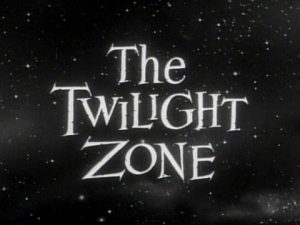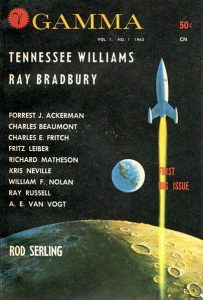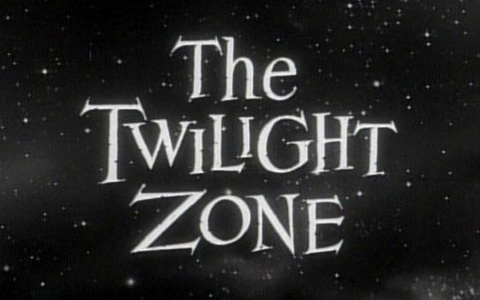
There is a fifth dimension beyond that which is known to man. It is a dimension as vast as space and as timeless as infinity. It is the middle ground between light and shadow, between science and superstition, and it lies between the pit of man’s fears and the summit of his knowledge. This is the dimension of imagination. It is an area which we call the Twilight Zone.
Sixty Years of THE TWILIGHT ZONE
Rod Serling’s THE TWILIGHT ZONE ran on CBS from 1959 to 1964. It remains in syndication to this very day. A new version of the series — narrated by filmmaker Jordan Peele — premiered on CBS All Access on April 1, 2019. Sixty years after its original debut, Rod Serling’s remarkable creation is still very much embedded in the public consciousness.
The creator of THE TWILIGHT ZONE was born on December 25, 1924 in Syracuse, New York. His brother, the late novelist and aviation writer Robert Serling, said: “We were fairly close as kids and we played together a hell of a lot, despite the seven-year difference. The two of us used to read AMAZING STORIES, ASTOUNDING STORIES, WEIRD TALES — all of the pulps. If we saw a movie together, we’d come home and act it out, just for the two of us.”
After serving in World War II as an army paratrooper, Rod Serling entered Antioch College in Ohio. He majored in language and literature and became involved in the college’s radio programming. While still in college, he began to sell his radio and television scripts. Long an admirer of Norman Corwin — a writer and producer who used entertainment to explore social issues — Serling complained that he was “. . . bitter about everything and at loose ends.” He began writing “. . . to get it off my chest.”
Rod Serling’s big break came in 1955 when KRAFT TELEVISION THEATER produced his drama, “Patterns.” It won the writer the first of his six Emmy awards. Serling’s “Requiem for a Heavyweight,” written for PLAYHOUSE 90, won him another Emmy in 1956. “The Comedian,” starring Mickey Rooney, won Serling a third Emmy in 1958.
At the top of the entertainment world, but still dissatisfied, Rod Serling began to search for a new way to get things off his chest. He had previously written science fiction and fantasy while working for THE STORM, a television series that aired live in the Cincinnati area. He had also attempted to sell a few science fiction scripts to the ABC series, TALES OF TOMORROW. However, having written no published science fiction or fantasy and — according to author Ray Bradbury — knowing little about the field, Serling turned these genres for his first television series. In a 1963 interview published in the first issue of GAMMA, Rod Serling explained:
“Because I loved this area of imaginative storytelling — and because there had never been a TV series like it. The strength of TWILIGHT ZONE is that through parables, through placing a social problem or controversial theme against a fantasy background you can make a point which, if more blatantly stated in a realistic frame, wouldn’t be acceptable. Because of this from time to time, we’ve been able to make some pertinent social comments on conformity, on prejudice, on political ideologies, without sponsor interference. It offered a whole new outlet, a new approach.”
 Although he wrote or adapted nearly sixty percent of the series’ 156 total episodes, Rod Serling also employed writers Ray Bradbury, Earl Hamner, Jr., Jerry Sohl, and his “three writing gremlins,” Charles Beaumont, George Clayton Johnson, and Richard Matheson, for the series. Most were actively writing science fiction or fantasy for the magazines of the day.
Although he wrote or adapted nearly sixty percent of the series’ 156 total episodes, Rod Serling also employed writers Ray Bradbury, Earl Hamner, Jr., Jerry Sohl, and his “three writing gremlins,” Charles Beaumont, George Clayton Johnson, and Richard Matheson, for the series. Most were actively writing science fiction or fantasy for the magazines of the day.
Join PulpFest 2019 on Friday, August 16, as we welcome Nicholas Parisi for “The Key of Imagination: THE TWILIGHT ZONE and the Pulps.” He will be discussing the creation and history of Rod Serling’s fantastic program and its relationship to the science fiction and fantasy pulps and digests. A former staff writer and editor for GOOD TIMES magazine, Nicholas is the author of ROD SERLING: HIS LIFE, WORK, AND IMAGINATION.
PulpFest 2019 will begin on Thursday, August 15, and run through Sunday, August 18. Join PulpFest at the DoubleTree by Hilton Hotel Pittsburgh – Cranberry, just north of Pennsylvania’s “Steel City” of Pittsburgh in Mars, PA.
To become a member of PulpFest 2019, click the Register button below our homepage banner. To book a room at the DoubleTree by Hilton — our host hotel — click the Book a Room button, also found on our homepage.
You unlock this door with the key of imagination. Beyond it is another dimension — a dimension of sound, a dimension of sight, a dimension of mind. You’re moving into a land of both shadow and substance, of things and ideas. You’ve just crossed over into the Twilight Zone.
(Rod Serling was interviewed for the first issue of GAMMA, a short-lived science fiction magazine that debuted in 1963. In addition to the Serling interview, five authors who wrote for THE TWILIGHT ZONE also had stories in the issue — Charles Beaumont, Ray Bradbury, George Clayton Johnson, Richard Matheson, and John Tomerlin. The cover painting for GAMMA #1 was by Morris Scott Dollens, an artist who got his start in the science fiction fanzines of the late 1930s.)







